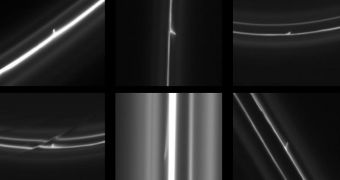The conclusions of a new study conducted using the NASA Cassini spacecraft appears to indicate that a large number of objects are making their way through the F Ring around Saturn. These snowballs are created by moons such as Prometheus, the analysis also revealed.
The strange objects can be up to a half-mile in size. When small Saturnine moons interact with the F Ring, they produce a host of effects, including the creation of ripples, channels and snowballs.
Astronomers have known about this for a long time. What remained unclear was what was happening to the snowballs after they were produced. Some were understandably ripped apart by the huge tidal and gravitational forces exerted by the planet, while others were destroyed by collisions.
However, some of these objects returned to pound the F Ring, zipping through its material, and producing glittering trails called mini-jets. The discovery helps scientists fill out a gap in our understanding of how the F Ring behaves.
Details of the study will be presented at the European Geosciences Union meeting, to be held in Vienna, Austria, on April 24. “I think the F ring is Saturn's weirdest ring, and these latest Cassini results go to show how the F ring is even more dynamic than we ever thought,” Carl Murray explains.
“These findings show us that the F ring region is like a bustling zoo of objects from a half mile to moons like Prometheus a hundred miles in size, creating a spectacular show,” adds the Queen Mary University of London expert, who is a member of the Cassini imaging team.
The spacecraft, managed by experts at the NASA Jet Propulsion Laboratory (JPL), in Pasadena, California, has been studying the gas giant, its moons and its ring systems since achieving orbital insertion around Saturn, on July 1, 2004.
According to the latest Cassini data, the snowballs collide with the F Ring at relatively low speeds, of just 4 miles per hour (2 meters per second). A large amount of ice particles from the ring are dragged behind the impactors, producing the mini-jets.
“The F ring has a circumference of 550,000 miles [881,000 kilometers], and these mini-jets are so tiny they took quite a bit of time and serendipity to find,” QMUL expert and Cassini imaging associate, Nick Attree, explains.
“We combed through 20,000 images and were delighted to find 500 examples of these rogues during just the seven years Cassini has been at Saturn,” the expert concludes.

 14 DAY TRIAL //
14 DAY TRIAL //